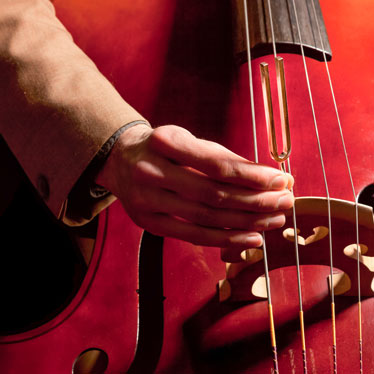Tips For Tuning Your Double Bass

One of the first things that string musicians must learn is how to properly tune their instrument. Although you probably know the basics, tuning your double bass can be a little tricky. Since its proportions are rather large, each string influences the others. Plus, the tuning is different from other string instruments, employing fourths rather than fifths.
Knowing how to tune your double bass requires three things: learning the process, constant practice, and patience. Essentially, you should check your bass for tune every time you play, so getting the practice pretty much takes care of itself. Learning the process is a simple matter of education and training, along with knowing a few tips to make it easier for beginning students. Gaining patience can be the trickiest part, and it largely depends on your own determination.
These tips can help you master those aspects, so that tuning your double bass becomes second-nature rather than a loathsome chore.
Get a digital tuner.
You won’t have to use this device forever, but for beginners, a digital tuner makes the process much, much easier. Later, once you’ve developed your ear, you’ll be able to use piano tones or another reference note as a starting-off point. At first, using a digital tuner will help you maintain consistency.
You can purchase digital tuners that clip onto the bridge of your double bass. As a tool, it is an excellent, inexpensive investment. The tuner reads the vibrations of the instrument to deliver very accurate results.
Understand your tuning.
There are a few different tunings used for the double bass and they reflect the type of music you want to play. Unlike other instruments in the violin family, the four string double bass is tuned in fourths, not fifths. Although there are some basses that have five strings, as a beginner bassist your four string model will typically feature the “orchestral” (standard) tuning of E, A, D, G.

This is the tuning used in most frequently in rock, jazz, bluegrass, and country music styles, and like its name suggests, by most orchestra bassists. The bass strings are sold as “orchestra gauge,” which are designed to offer the best response and tension for this tuning.
In addition to the standard tuning, solo tuning is employed when you are performing solo in a classical music setting. Beginners don’t often utilize this tuning, but it can be good to know. It is simply one step higher than standard tuning, resulting in F#, B, E, A.

You can also utilize the fifths tuning, one octave below the cello. Many professionals use this method because of the increased resonance it produces. You’ll need to purchase strings labeled “Red Mitchell” or “5ths.”

Although the “Combination” tuning of E, B, E, A has been gaining in popularity over the past 20 years, this mix of fourths and fifths is used by more advanced bassists, for specific styles.
Tuning Technique
If you’re using a clip-on style tuner, clip it onto your bridge. However, if you’re using a model that doesn’t attach, that’s fine too, just try to set it as near as possible to the F-holes. For example, place a chair or stool in front of your double bass when tuning.
Start with the open G and pluck the string. Remember, like all string instruments, you want to work (if possible) up towards the correct pitch rather than loosening the string. Because the strings are under pressure, gradually increasing the tension on the string is more stable than releasing it.
When the G string is tuned, move on to the D. Follow the same procedure, going to the A and then E.
Tuning Tips
- It’s important to remember that the tension on all of the strings affects all of the others, so once you’ve made the first pass, tuning each of the strings, go back and check each one. It’s a good idea to do this at least twice.
- Use half turns and then smaller adjustments to bring the string up to pitch.
- Don’t be alarmed if your bass strings creak or crack when you are increasing the tension. This is normal for most instruments.
- Small clip-on tuners are typically less than $10 and easily fit in your case, so it's a good idea to purchase an extra one for emergencies. For instance, if the battery in your primary one goes out, or you need to tune your bass quickly for a performance.
Learning to tune your double bass properly is crucial for beginner students. Without the strings at the right pitch, your intonation will suffer during practice. However, if you take your time and make sure your instrument is tuned correctly every time you play, you’ll be able to improve your progress.


